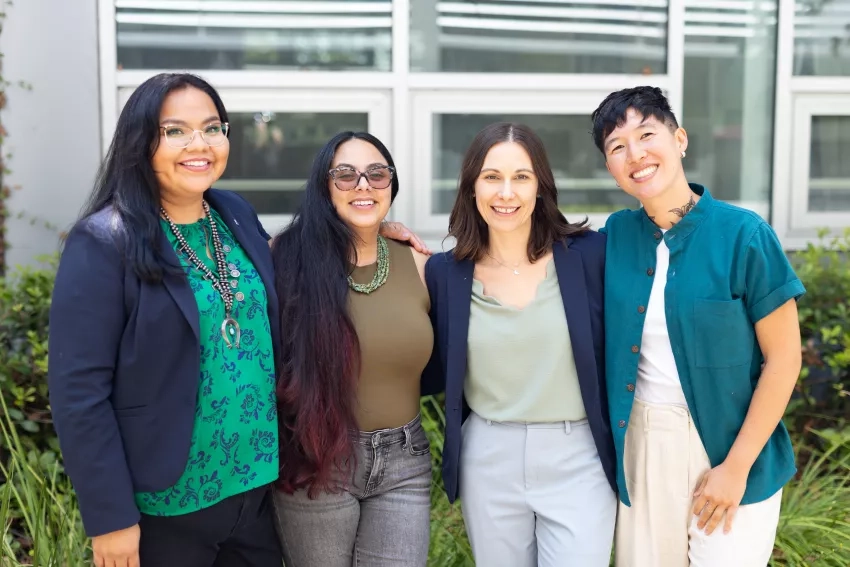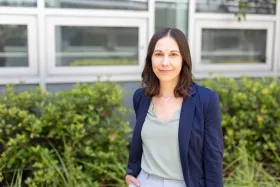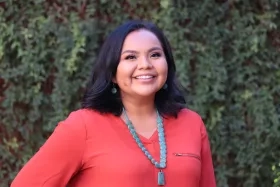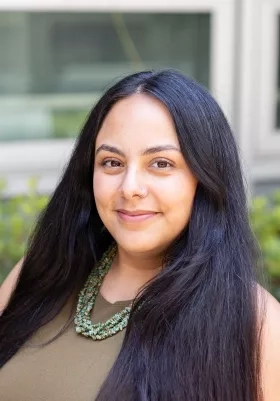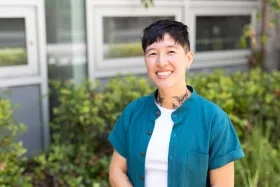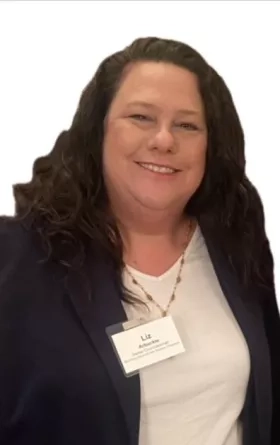Empowering indigenous people to increase their use of Earth Observations to maintain and sustain healthy ecosystems and communities
The Indigenous Peoples Initiative focuses on building relationships across NASA and Indigenous communities through place-based remote sensing training, community engagement, and co-production of knowledge.
NASA’s Indigenous Peoples Initiative (IPI) is committed to supporting and cultivating efforts within Indigenous communities and NASA to increase the use of Earth Observations (EO) to inform decisions, policies, and actions. We connect with natural resource managers and community members through engagement activities at conferences and meetings, through co-hosted community events, and through listening sessions around EO needs for landscape monitoring and mapping. We co-develop place-based in-person and online trainings focused on content relevant to Indigenous lands and territories. We support Indigenous-led initiatives and projects that utilize NASA data, products, and tools. We communicate and uphold respectful and reciprocal engagement strategies within NASA’s Earth Science Division to cultivate healthy relationships. We create opportunities for Indigenous people at NASA to diversity worldviews within Earth Science.
Read our 2023 Annual Report.
Strategic goals
Goal 1: Cultivate knowledge sharing pathways around the use of Earth Observations (EO) for Indigenous community action within landscapes Goal 2: Strengthen the capacity for the use of NASA EO data and tools for Indigenous community action Goal 3: Uphold and share respectful and reciprocal engagement strategies across NASA Earth Science for Indigenous community action Goal 4: Increase presence of Indigenous people at NASA to diversify worldviews within Earth Science
Geospatial Trainings
Through in-person and virtual workshops, the Indigenous Peoples Initiative provides place-based and culturally relevant approaches to the use of NASA Earth observations for water resources/drought monitoring, wildfires, habitat monitoring, land cover change, and ocean and coastal applications.
These trainings are needs-based and begin with dialogue around the appropriate geospatial tools, themes, and techniques to improve the capacity within the Tribe or Indigenous community to use Earth observations. This includes the use of web-based and open-source software. Past trainings have provided lessons and hands-on exercises on topics such as: introduction to remote sensing, vegetation health and calculation of indices, land cover classification, accuracy assessment of maps, coastal and wetland mapping, drought and agricultural monitoring, and much more.
Trainings have been conducted in partnership with tribal natural resource management offices, regional tribal networks, tribal colleges, and other federal agencies. The Indigenous Peoples Initiative has worked with Tribal Nations and Indigenous organizations such as the Navajo Nation, the Samish Indian Nation, the Sault Ste. Marie Tribe of Chippewa Indians, the Institute of Tribal Environmental Professionals, Northwest Indian College, the United Tribes Technical College, the Indigenous Mapping collective, and more to provide these trainings.
[ TRAINING: An Introduction to Remote Sensing for Tribal Lands ]
Building Relationships
The Indigenous Peoples Initiative connects, cultivates, and sustains relationships. Our team is focused on engagement, dialogue, and two-way learning through connecting with natural resource managers and community members at conferences and meetings, through co-hosted community events where involving youth and elders, and through listening sessions around EO needs for landscape monitoring and mapping. We believe that “relationships move at the speed of trust” and are dedicated to building lasting relationships with Indigenous communities by creating a trusted, reliable, and Indigenous-centric geospatial community with a focus on environmental justice and climate issues on Indigenous lands and territories.
highlights include:
A knowledge exchange workshop held in collaboration with the Red Cliff Band of Lake Superior Chippewa, which focused on building partnerships with NASA and the tribal nations, Indigenous knowledge systems and "two-eyed" seeing, and future recommendations for the Indigenous Peoples Initiative. Conference sessions and co-developed trainings held at with Tribal Natural Resources departments such as with the Karuk Tribe and the Samish Indian Nation, and at conferences and workshops such as the National Tribal GIS Conference, the Tribal Leaders Summit, the Society for Conservation GIS, the National Adaptation Forum, the National Tribal Climate Change Conference, the Native American Fish and Wildlife Conference, and the Indigenous Mapping Workshops. Community based events such as the co-hosted Nihimá Nahasdzáán: The Art of Mother Earth Gallery event on the Navajo Nation in collaboration with the Navajo Nation Museum, the USGS, AmericaView, and Google that was intended to engage with the whole community, from youth to elders, to build trust, establish relationships, increase awareness of NASA Earth Science data, products, and tools.
Get connected
NASA partners with tribal natural resource management offices, regional Indigenous organizations, tribal colleges and other federal agencies to conduct trainings on tribal lands. The Indigenous Peoples Initiative has hosted events with groups including:
- The Navajo Nation Department of Water Resources
- The Samish Indian Nation Department of Natural Resources
- The Sault Ste. Marie Tribe of Chippewa Indians Department of Natural Resources
- The Institute of Tribal Environmental Professionals
- The Firelight Group
- Northwest Indian College
- The United Tribes Technical College
- The Bureau of Indian Affairs Branch of Geospatial Support
GET IN TOUCH
If you or your organization is interested in connecting, please contact us.
Our Team
Dr. Amber Jean McCullum is a researcher and capacity building specialist in the Earth Science Division at NASA Ames Research Center. She resides on the ancestral and unceded land of the Chochenyo speaking Ohlone people in Oakland, California. Her work in Earth Action focuses on project management, engagement and relationship building across NASA and Indigenous communities, and creating remote sensing trainings for land and water applications. She is the program manager for the Indigenous Peoples Initiative, where she has worked towards creating a more equitable and inclusive space for the use of Earth Observations for Indigenous community action. She is also the Impact and Transition Lead for NASA's Western Water Applications Office (WWAO). She has led multiple projects centered around the co-development of remote sensing tools for example with the Navajo Nation Drought Severity Evaluation Tool. She received her B.S. in Geology and Environmental Geosciences from the College of Charleston, her M.S. in Geology from San Francisco State University, and her PhD in Environmental Studies from the University of California Santa Cruz.
Nikki Tulley is a member of the Navajo Nation, an Indigenous Nation located in the United States southwest. She is an Assistant Research Scientist with BAERI/NASA Ames Research Center and is an Associate Program Manager with the Equity & Environmental Justice Program with Earth Science Division’s Earth Action Program. The work and research Nikki does is highly influenced by her upbringing. Born and raised on the Navajo Nation Reservation, she has seen firsthand the impacts of water access and water quality challenges rural communities face. Now, as an Indigenous Scientist, she recognizes that opportunity to braid Indigenous science and Western science together to empower communities through collaborative efforts. As a team member of NASA’s Indigenous Peoples Initiative, she works to foster ethical and culturally relevant space for the use of Earth observations in Indigenous communities. Nikki holds a passion to empower communities through data access and capacity building. She believes that community involvement in research can significantly aid in seeking solutions for resilient and sustainable communities.
Sativa Cruz (Chicana/Genízaro/Tewa) is an Indigenous Scientist, Creative and Educator in the Earth Science Division at NASA Ames Research Center. Following an internship with NASA Headquarters, where she supported Environmental Justice efforts within the Applied Sciences Program, she joined NASA’s Indigenous Peoples Initiative (IPI). Sativa supports the IPI’s capacity building efforts through the co-creation of place-based remote sensing trainings for Tribal natural resource professionals and Native communities. She is also part of the Applied Remote Sensing and Training (ARSET) Ecological Conservation team where she works as an instructor to further enable use of Earth of Observations at the global scale. Her academic background includes a BSc. in Environmental Science and a minor in Sustainability from New Mexico State University, as well as a M.F. in Forest Ecosystems and Society from Oregon State University. She is completing a hydrology degree at the New Mexico Institute of Mining and Technology (anticipated 2025). Sativa was raised in O’gah P’ogeh (Tewa land also known as Santa Fe, NM) and resides there with her partner and young son. She is a member of Ohkay Owingeh Pueblo located in Northern NM.
Victoria Ly is a research scientist and engineer at NASA Ames Research Center. Victoria has over 10 years of experience in climate modeling and adaptation, water resource management, flood risk modeling, snow hydrology, and remote sensing. As the technical specialist of NASA’s Indigenous Peoples Initiative, they provide technical support to tribal partners through listening to community needs, co-development of educational materials, tool(s), trainings, and projects.
Victoria is a Chinese-Vietnamese, queer, second-generation immigrant currently residing in the territories of the xučyun (Huichin), the ancestral and unceded land of the Chochenyo speaking Ohlone people in Oakland, California. Their work and research is influenced by their intersectional background and identities, and grounded in community empowerment, collective liberation, and the vision of ecological harmony. They received a B.S. in Environmental Sciences from UC Berkeley and M.S. in Civil and Environmental Engineering from University of Washington.
Liz Arbuckle, PhD. is a member of the Bad River Band of Lake Superior Chippewa in northern Wisconsin, where she resides. She is the Indigenous Engagement Coordinator for NASA’s Indigenous Peoples Initiative. She also currently serves as Senior Councilwoman on Bad River’s Tribal Council, the Tribe’s legislative body; and as a Tribal Gaming Commissioner. She serves on the Wisconsin Legislative Council Special Committee on State-Tribal Relations, and has served on the Bad River Education Committee, Indian Health Board, Constitution Revision Committee, and was a founding member of their Police Commission. She taught political science and American Indian studies at the University of Wisconsin-Stevens Point, and Northern Arizona University. She has a bachelor’s degree from the University of Wisconsin-Madison and a Ph.D. in political science from the University of Michigan. Liz is the mother of two beautiful, brilliant daughters; and founder of Rezberries, Bad River’s 4-H club.


